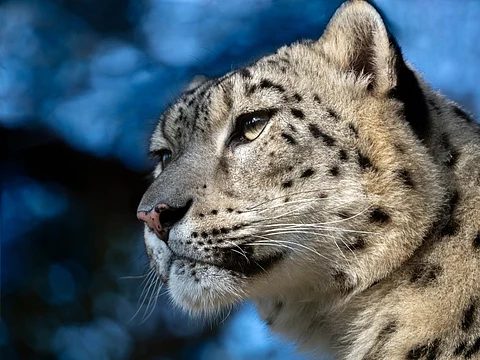
- Destinations
- Experiences
- Stay
- What's new
- Celebrating People
- Responsible Tourism
- CampaignsCampaigns
- SubscribeSubscribe
- Buy Now

A new study released in May 2025 found that the union territory of Ladakh is home to 68 per cent of India’s total snow leopard population. Published in the scientific journal “PLOS One,” the study, which spanned two years and 59,000 sq km across trans-Himalayan Ladakh, estimates that around 477 snow leopards live in the cold, rocky slopes of the region.
These “ghosts of the mountains” are stunning, mysterious and elusive creatures. Their home range extends from 200 to 2000 sq km in the Himalayas and mountains of Central Asia. The animals are held in high regard by local Ladakhi communities, many of whom work in the tourism industry and plan excursions for the thousands of wildlife enthusiasts who visit the region just to see them.
One of the people leading snow leopard tours is Morup Namgail, a wildlife photographer who runs the Shan, an eco-friendly wildlife lodge in the picturesque Uley Valley. He says that ascertaining their numbers on field visits into places like Hemis National Park is quite difficult. But, the findings of the study tracks with his own personal observations of the big cat.
“In Uley, we have generally counted around 12-13 snow leopards in the area. If we extrapolate that into the entire region’s landscape area, it does come to a great number and looks similar to what we can understand,” he says.
“There is no noticeable movement changes that I could say we have observed over the years because looking and taking photos of snow leopards is always a process, no matter how many years of experience you have. You do get to learn new things every time you see them or you go somewhere and look for them. It will never be enough to know more things about snow leopards.”
What we know about the snow leopard so far is this: evolution has adapted the big cats to the rocky mountains and high-altitude of Ladakh. They like to hunt in places with many cliffs and rugged paths, where they can hide and sneak up on prey. The region is rich in wild animals like blue sheep and Asiatic ibex, which are their primary prey species. Weighing around 30-55 kg, the animals are mostly solitary and usually active at dawn and dusk. Their smoky-grey fur is patterned with dark-grey to black rosettes, which helps to camouflage them against the rocky slopes. They mate between January and March, a time when both sexes mark their territories intensively, leaving signs such as scrapes, faeces, urine and scent-spray in prominent locations along their travel routes.
Most communities in Ladakh respect the snow leopard because of their religious beliefs. Namgail says that religion plays an important role in this “because as Buddhists, we always want to treat all kinds of animals with love and compassion.” But things can take a turn if the animal targets livestock, whose rearing has historically formed the backbone of the region’s socioeconomic and cultural fabric.
Human-wildlife conflict, a term that some scientists have contested as being misleading, is a pertinent issue as habitats of wild animals shrink due to the climate crisis. From encounters with elephants in Assam to entanglements with tigers in Maharashtra, humans and wildlife are increasingly interacting and competing for the same resources.
Although there has been limited research on the impact of climate breakdown on Ladakh’s wild animals, according to Dr Tsewang Namgail, Director of the Snow Leopard Conservancy India Trust (SLC-IT), there are telltale signs that the prey species of snow leopards are moving upslope—and the big cats are following suit. But he says that moving towards human-wildlife coexistence is not a pipe dream.
“Things are changing thanks to the pioneering efforts of the SLC-IT that involve the community directly. People in several villages now take part in a livestock insurance program, controlled by the villagers themselves, with some overseen by us,” Namgail tells Outlook Traveller.
“If a snow leopard kills a domestic animal that is insured, the owner gets full compensation, unlike in the government-run compensation scheme, where only a fraction of the value of the animal is received by the owner. This helps people feel less angry and avoids killing the snow leopards in revenge.”
To tap into Ladakh’s booming tourism market, the SLC-IT has been running a conservation-linked homestay program since 2002 with the help of the government. With homestays in over 40 villages, the additional income generated by families helps offset livestock loss to the snow leopard.
“Thanks to these programs, people now see snow leopards not as troublemakers, but as ‘Ri Gyancha,’ which translates to ornaments of the mountains. Today, the snow leopard is worth more alive than dead,” says Tsewang Namgail.
Beyond controlling the free-ranging dog population, which has become an important threat to the snow leopard as well as other wild animals in Ladakh, stemming habitat destruction and restoring degraded habitats, and carrying out more studies on the impact of climate breakdown on the animals, Tsewang Namgail says that regulating mass tourism is also crucial to minimising the negative impact on the snow leopard population.
For Morup Namgail, another way of conserving this keystone species is through propagating photographs and video footage of the predator to help support its conservation.
“Many of us don’t know what’s up there in the mountains. We are sharing our home with such elusive and important creatures,” he says.
“Friends of mine and local youth already ask like lots of questions and they grow [their] interest and curiosity [so much] that they go [to] see them. This really helps a lot in their conservation.
“When we start loving an animal from [the] core of our heart, then definitely you would want to do anything to help them in any way.”
